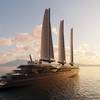Top Maritime Trends of 2020: Decarbonization is Blowing in the Wind
The global shipping industry is going to face a big challenge during the coming years when regulators, investors and stakeholders demand the drastic reduction of CO2 and other GHG emissions during ship operations. But in reality, the change is already underway.
Since 2013, any newbuild ship over 400GRT has been obliged to comply with a specific Energy Efficiency limits – the well-known Energy Efficiency Design Index (EEDI). It is about to enter an accelerating phase propelled by the recently released IMO GHG reduction strategy. Today, this portion of EEDI compliant fleet is around 22-23%, exhibiting a 15-25% reduced fuel consumption on same design conditions compared to older tonnage and creating a two-tier fleet categorization – ‘eco’ and ‘non-eco’ ships. For the existing non-eco fleet built before 2014 (about 64,000 ships over 400 GRT), there are not many options to achieve prompt compliance with the IMO GHG and EU-ETS phase-out. Speed reduction is an obvious choice, but that along might bring commercial deficiencies, especially compared to eco-ships that can sail faster. Other low-cost options include hull appendages optimization (energy saving devices), improved engine tuning, meticulous voyage optimization and performance monitoring, weather routing; but again these can offer a range of 3-10% max fuel consumption reduction, far from a least 20% as to be required for the first 2023 IMO GHG phase; especially difficult for larger ships.
If the power reduction has a commercial disadvantage and since the global fleet is equipped with combustion engines as prime movers that use fuels, a logical option is to seek for alternative fuels with lower carbon footprint than marine diesel oil or heavy fuel oil. While the alternatives (LNG, LPG, Methanol, ammonia, hydrogen) can help, the retrofit costs – $3-$5 million for the smallest ships – is still quite high.
- From Sail to Steam to Diesel … to Sail?
Wind-assist ship propulsion (WASP) technologies is an option to consider. Wind assist propulsion technologies are technologies using the available ocean and coastal winds for assisting propulsion, suited for retrofitting ships which have already a powerful prime mover and which have not been designed for as full wind-propelled ships.
The current such technologies comprise of smart mechanical sails, which are specifically designed to develop aerodynamic forces through a much smaller surface area than conventional soft sails, while they do not have rigs or other reefing, furling or twisting rope mechanisms, making the installation easier.
Rotors are composite material rotating cylinders which exploit the Magnus effect, thus generating high lift forces due to the pressure field variation that they artificially generate around the perimeter of the cylinder, coming from a self-rotation imposed by a relatively small power consumption they need. Their maximum size installed so far is 30m x 5m and smaller rotors are workable for certain ship sizes.
The wing sails are airplane wing-shaped aerofoils, which can either be reefable or fixed, and rotate around their vertical axis to find each time the optimal angle of higher lift (and higher forward thrust force) generation. Compared to rotors, they have about four times larger surface area for a same total thrust force.
Suction wings are operating like the wing sails, but they have instead an egg-shaped, thick chorded aerofoil, which generates a lot of drag during a cross flow stream applied on them, but when an internal ventilator operates and sucks internally the wing’s surface air, the disturbed boundary layer is reducing dramatically and their lift force becomes very high. They can have a smaller size than rotors and produce the same lift and thrust force, with less power consumption.
All these are deck-mounted systems, which might interfere with cargo operations, impose bridge visibility restrictions, or having air draft limitations.
The propulsion kite is another interesting technology which works off-deck, at a high altitude over 150m where wind forces are 1.5-2 times stronger and with no ground level windage resistance interactions.
Because of its dynamic movement and the high-altitude strong winds, the Kite can produce remarkably high relative speeds on its surface thus generating very high lift for a much smaller surface. The only limitation of performance is the Kite parachute material strength.
The Kite seems ideal for ships that have crammed deck superstructures, cargo cranes or other operational limitations.
Despite being a newly adopted application there are about 15 ships in waters today that run with wind assisted propulsion systems, and more are contracted, thus expected to double by 2022. Every such technology under certain wind conditions (speed and direction) will deliver a propulsion thrust (and power) spectrum for a given ship and deck arrangement, basis the aerodynamic physics applied.
Then, certain restrictions such as interaction effects, windage resistance, boundary layer alterations, hull heel and leeway generation and limits for ships safety, rudder effect and propeller efficiency reduction, all will apply aggregately on the theoretical figures for the specific ship.
It then depends on the utilization of the system: the more it is used, the higher the annual energy yields. The utilization is dramatically improved by continuous voyage optimization and weather routing, where studies have shown that it can raise the benefits by even an extra 40% in specific routes.
From various projects assessed so far, considering different ship types and arrangements, considering global wind statistics, frequent trading routes and average sailing speeds, it seems that wind propulsion systems can deliver a range of 5-8 tons/day fuel consumption savings per ship size, considering a theoretical forward thrust force with all restrictive parameters as mentioned above factored in. If a ship has an average specific fuel consumption of 200 gr/kWh for the main engine – which is a typical realistic consumption taking into consideration engine margins, engine condition and fuel quality (we are talking about existing ships here, over 7 years old), a realistic propulsive efficiency of 0.6 and a sailing speed of 12kn, this translates to a net forward delivered thrust of abt 100kN – 165kN.
Such range of net forward thrust can be generated within the proven statistically high global wind intensities range of BF 4-6 (i.e an average 20kn wind speed) by 2 – 3 rotors on deck, or 3-4 wing sails or a 400m2 airborne Kite system.
For a 170m, 28,000 dwt handysize cargo ship, this is a 30% fuel saving in such above average conditions per time used, and for an Aframax tanker it is a 15%, all considering a stable speed of 12kn. All that for a total capex of $1-2.5 million, depending on the arrangement.
- Setting Up the System
The key question here for assessing the Annual energy yield of any system and configuration and optimize the Investment, is the ‘Time Used’. And this is directly depended on the how and when the operators will finally use the system on board.
To integrate properly a wind propulsion technology on a ship, the most suitable arrangement has to be studied which will fit on deck without interrupting cargo operations or pose other operational obstacles (i.e. such as bridge passage limitations), but also arranged in a way to work without impairing the ship’s course keeping, maneuvering abilities and stability limits.
This requires detailed performance prediction analysis, naval architecture and engineering studies which are recommended to be performed by wind propulsion specialists even on feasibility level before any investment decision on wind-assist propulsion is made.
To maximize the energy yield potential of deck fitted wind propulsors beyond the ship’s existing hull seakeeping limitations – since existing ships were not designed considering aerodynamics force of high magnitude and dynamics as input values – it is possible to retrofit them with extra hull appendages such as extended bilge keels, stern fins or others, which are again a subject of engineering analysis.
For those ship owners and operators that wish to investigate further the potential of wind-assisted propulsion, understand the working principles of the technologies, review the criteria which need to be satisfied and identify the factors to be considered for both existing and newbuilding ship applications, the first shipping Industry publication is available since the summer of 2020.
 The Author: Konstantinos Fakiolas is a Naval Architect and marine engineer, ship design and hydrodynamics expert with over 10 years specialization in energy efficiency technological applications on ships and customized design development for newbuildings. Since 2014 he has been involved in wind propulsion projects, participating in global research programs and the first WASP ship contracts. He is CEO of FINOCEAN LTD based in Finland, a project management and consulting company focusing on enhancing energy efficiency and enabling optimal decarbonization of shipping.
The Author: Konstantinos Fakiolas is a Naval Architect and marine engineer, ship design and hydrodynamics expert with over 10 years specialization in energy efficiency technological applications on ships and customized design development for newbuildings. Since 2014 he has been involved in wind propulsion projects, participating in global research programs and the first WASP ship contracts. He is CEO of FINOCEAN LTD based in Finland, a project management and consulting company focusing on enhancing energy efficiency and enabling optimal decarbonization of shipping.











